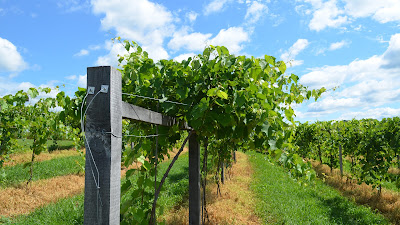With at least 165 wineries and over 100 miles of wine trails, the wine industry in Illinois is thriving and the growth has been exponential in the last 30 years. Illinois is now the 12th-largest wine producing state in the country, which is remarkable considering there were only 12 wineries in the entire state in 1997. Award winning wines in Illinois are made from Native American, French Hybrid and Vinifera grapes, as well as a local fruit. Rose wine is the official wine of Illinois.
The number of wineries in Illinois exploded in the 2000s, climbing to 27 in 2001, 63 in 2004, 77 in 2006, 105 in 2011 to now 165 and counting in 2023 according to the Illinois Grape Growers and Vintners Alliance (IGGVA). Wine-making dates back to 1691 in Illinois in an area just north of what is now Peoria. French descendants built a fort in the area, and the village surrounding it contained a winepress. Vineyards and wineries increased rapidly in the 1850s, and by 1868 there were approximately 225,000 gallons of wine being produced in Illinois. By 1880, over 3,000 acres of grapes were planted and the state was producing over one million gallons of wine, and by 1900 Illinois was the fourth largest wine-producing state in the nation.
Then along came Prohibition in 1919, and that brought almost all wine production to a halt. During this period of time, which lasted 14 years, some vineyards continued to grow table grapes while others uprooted their vines to plant corn and soybeans and never went back to wine production once Prohibition ended in 1933. During Prohibition, the Baxter brothers established the Gem City Vineland Company and remained in business by selling grapes to northern markets for personal wine making and consumption. Once Prohibition ended, the Baxter family obtained a wine manufacturing license and established the first bonded winery in Illinois. Baxter Vineyard and Winery in Nauvoo remains Illinois’ oldest operating winery and is run by a fifth generation of the Baxter family.
The wine industry did not begin to recover much from Prohibition in Illinois until the late 1970s, following a 1976 law that was passed that allowed wineries to sell wine to consumers on site. In the 1980s and 1990s wineries were established in the north, central and southern parts of the state, and in the early 2000s the Shawnee Hills region in Jackson County in deep southern Illinois became one of the largest grape growing regions in the state due to its heightened elevation, well-draining soil and summer breezes that reduced fungal infestation.
And the explosion of wine-making facilities, vineyards and tasting rooms has also brought an increase in quality. At the annual Illinois State Fair Wine Competition, just over 10 percent of wines submitted received a gold or double gold award in 2009. By 2021, that number increased to over 25 percent.
“I’m excited for the new economic opportunities possible in light of Illinois’ growing wine industry,” Rep. Friess said. “Here in Red Bed we have the beautiful Pour Vineyard, a definite highlight of the rich varieties of wine being produced in southern Illinois. As the wine industry continues to grow here, I see enormous benefits incoming for our economy, both locally and state-wide.”
Rep. Friess proudly serves the people of the 115th district.
